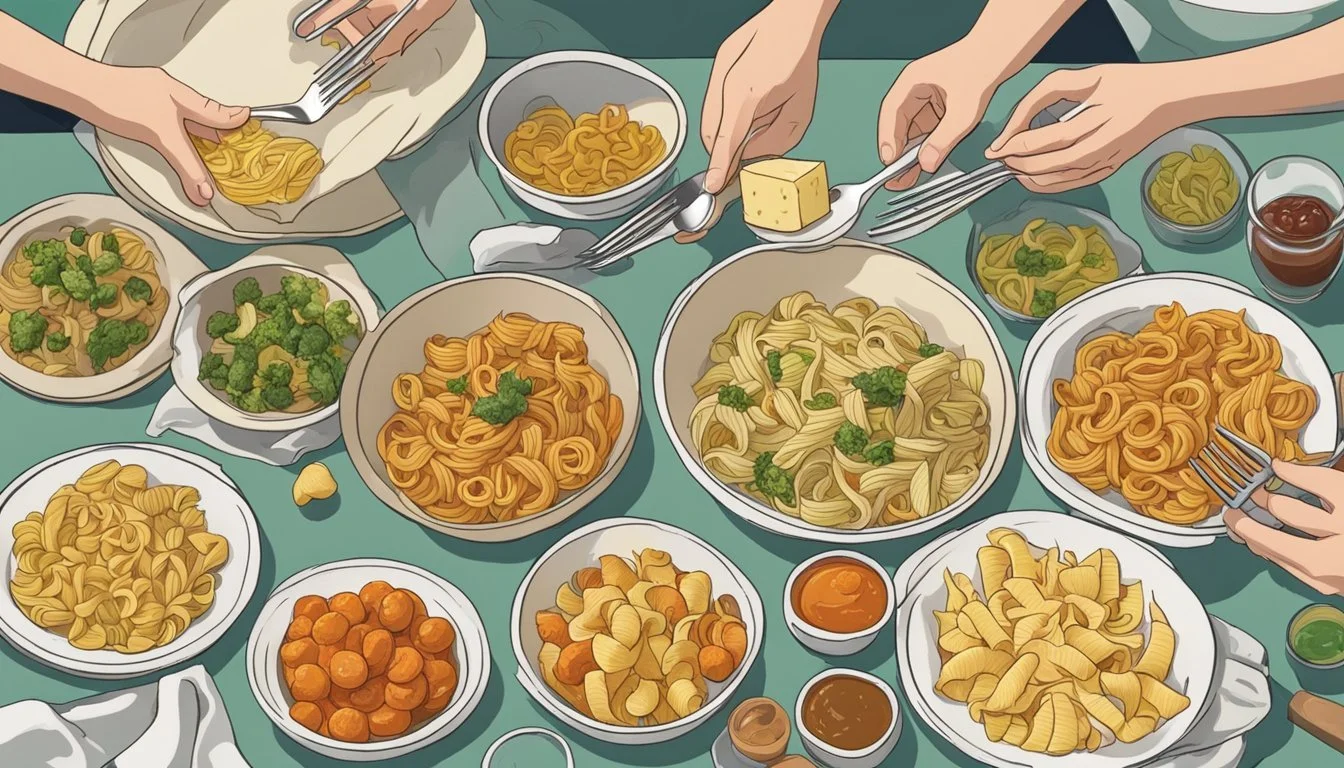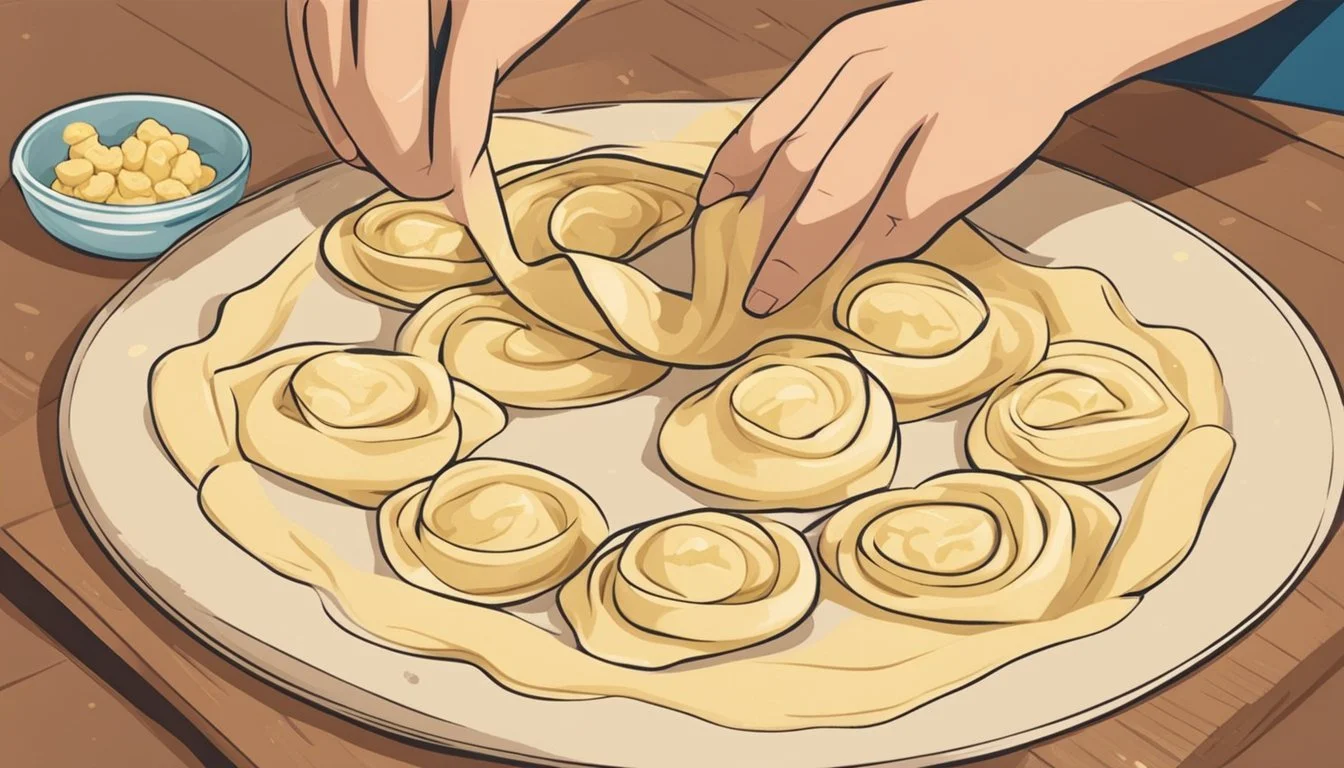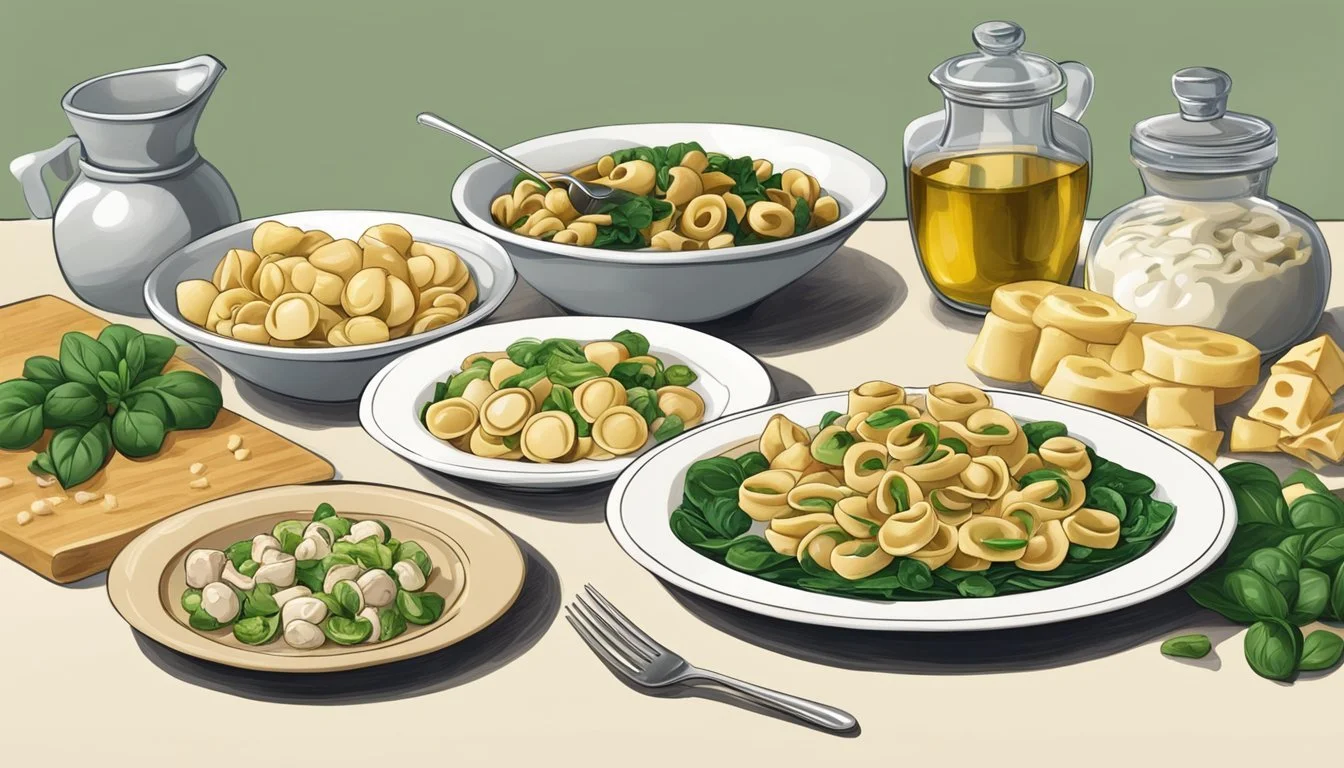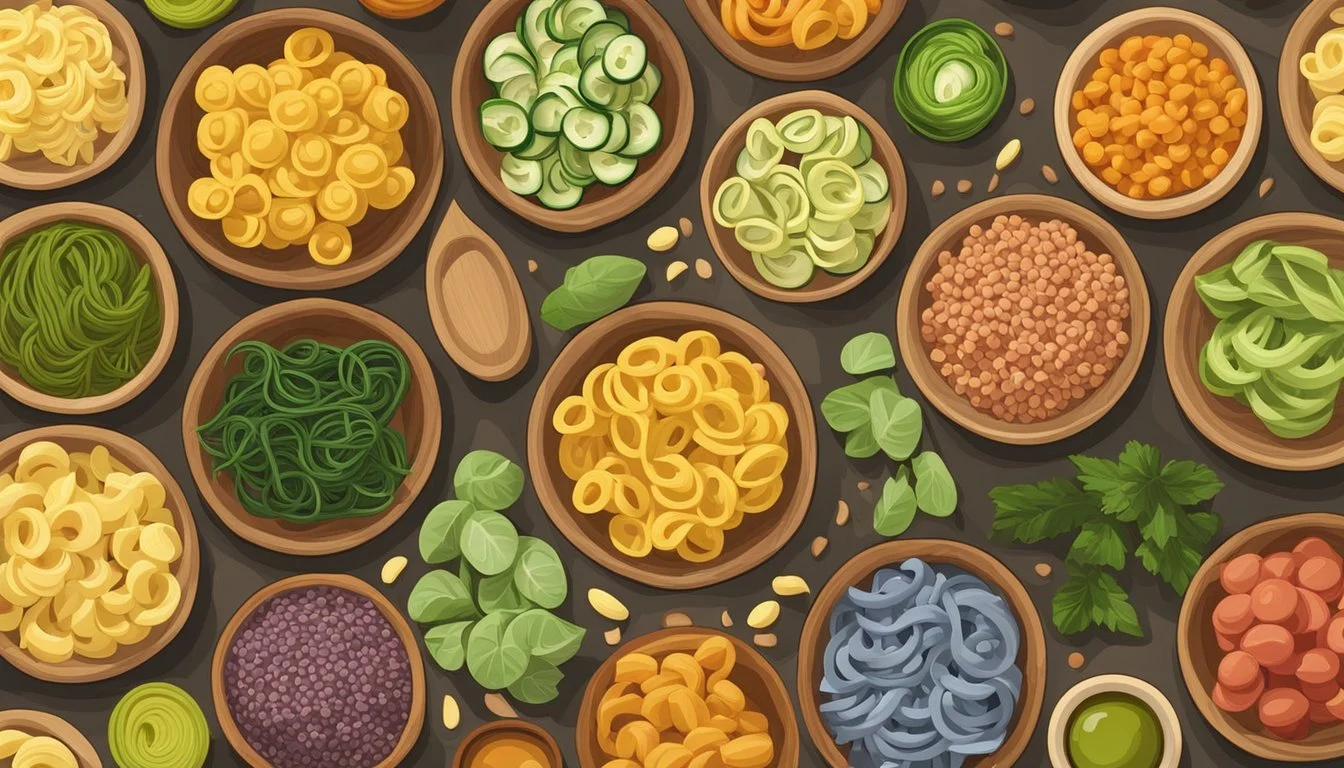Cappelletti Pasta Substitutes
Top Alternatives for Your Recipes
Cappelletti, a stuffed pasta (What wine goes well with pasta?) resembling small hats, is a staple in Italian cuisine and cherished for its delicate filling and flavorful pairing with broth. Traditionally, cappelletti is made with a simple blend of flour and eggs, yielding a firm and smooth dough. The filling often includes a mixture of cheeses such as Parmigiano, meats like mortadella, and a touch of seasoning such as nutmeg. Yet, for those seeking alternatives to the traditional cappelletti, whether due to dietary restrictions or a desire for variety, a range of substitutes are available without compromising on taste.
Healthy pasta substitutes offer a plethora of options tailored to different preferences, including gluten-free and low-carbohydrate choices. Instead of wheat-based pasta, alternatives like rice noodles, brown rice pasta, or kelp noodles can be used. Each substitute retains the versatility of pasta, making them suitable for a variety of dishes, from soups to salads, while also aligning with specific nutritional needs. The task then becomes choosing the appropriate substitute to complement the flavors and textures of the signature dishes one intends to replicate or reinvent.
For a successful substitution, the cook must consider both the cooking properties and the flavor profile of the alternatives. For instance, to replace cappelletti in broth, one might opt for substitutes that absorb and complement the warm savoriness of the broth without becoming too soft. The cooking times may also differ, with some alternatives requiring a shorter cooking duration to maintain the desired texture. Thus, the key is to balance the properties of the chosen substitute with the traditional sensibilities of the cappelletti dish, ensuring a satisfying gastronomic experience.
Understanding Cappelletti Pasta
Cappelletti pasta is a traditional Italian stuffed pasta that is reminiscent of small hats, which the name literally means in Italian. The dough is typically made with a blend of flour and eggs, and it's crucial to achieve the right consistency to ensure the pasta cooks to an al dente texture.
Key Ingredients & Preparation:
Dough: Made by kneading together flour and eggs with a pinch of salt.
Filling: Often includes a mixture of cheese, beef, pork, chicken, or mortadella for non-vegetarian versions. For vegetarian options, cheese and vegetables are popular.
Seasonings: Commonly uses grated Parmesan and a hint of nutmeg for added flavor.
Cappelletti is folded into a distinctive shape resembling a triangle or a hat, this requires precise technique.
Cooking Method:
Typically simmered in a rich broth, such as a well-prepared chicken or duck stock.
Alternatively, it can be served with a variety of sauces, where it's briefly tossed to meld flavors together.
The pasta's fillings and cooking styles vary by region and personal recipe, but they are invariably defined by a careful balance of ingredients with an emphasis on subtlety and depth of flavor. Cappelletti offers a hearty and comforting dish that is both versatile and expressive of Italian culinary tradition.
Reasons for Seeking Alternatives
Individuals often seek alternatives to traditional cappelletti pasta for a variety of health and lifestyle reasons. Dietary restrictions play a pivotal role, with many people adopting special diets that limit or exclude certain ingredients found in conventional pasta.
For those with gluten intolerance or celiac disease, gluten-free options are essential. Cappelletti, typically made from wheat, must be substituted with gluten-free alternatives to avoid adverse health effects. Allergies to wheat or eggs, which are common in pasta, also necessitate alternatives for safe consumption.
The rise of low-carb diets and weight loss strategies has contributed to the popularity of pasta substitutes. Nutrition-conscious diners may choose alternatives that are lower in carbohydrates to help manage weight or blood sugar levels.
In terms of cuisine variation, some may opt for ingredients that are more commonly found in their local or national dishes, enhancing the cultural relevance and acceptance of the meal.
Ingredient accessibility is another factor; in some regions, traditional pasta ingredients might not be readily available, while substitutes like rice noodles or spiralized vegetables are.
Lastly, a variety of pasta alternatives have become more prominent as consumers desire more diverse and health-forward options. This includes pasta made from legumes, vegetables, or ancient grains that cater to personal health goals, such as increased protein intake or a gluten-free diet.
Table 1: Common Cappelletti Pasta Alternatives and Benefits
Alternative Dietary Benefit Notable Feature Rice Noodles Gluten-Free Light Texture Zucchini Noodles Low-Carb Versatile in Dishes Quinoa (What wine goes well with quinoa?) Pasta High in Protein Suitable for Vegans Shirataki Noodles Low-Calorie Made from Konjac Plant
Choosing substitutes for traditional cappelletti involves balancing nutrition, dietary needs, and personal taste to maintain the essence of the dish while making it suitable for all diners.
Pasta Substitute Types and Their Characteristics
Exploring pasta substitutes, one can find a variety of options ranging from low-carb and gluten-free alternatives to vegetable-based and grain-infused varieties, meticulously considering dietary preferences and nutritional benefits.
Low-Carb and Gluten-Free Alternatives
Low-carb and gluten-free alternatives cater to specific dietary needs while still providing the satisfaction of traditional pasta. Shirataki noodles, made from the konjac plant, are a prominent low-carb pasta alternative with a near-zero calorie count and minimal carbohydrates. Brown rice pasta offers a gluten-free option that closely resembles the texture of wheat pasta but is made from ground brown rice. It's an excellent source of fiber and is easier to digest for those with gluten sensitivities.
Vegetable-Based Options
Vegetable-based options serve as a fresh and nutritious substitute for traditional pasta. Spiralized vegetables, like zucchini, carrots, beets, and cucumbers, require a spiralizer or a food processor to create noodle-like strands. These can be briefly cooked or served raw and are rich in vitamins and minerals. Another vegetable substitute, spaghetti squash, when roasted and scraped with a fork, transforms into strands resembling spaghetti, offering a low-calorie, nutrient-packed alternative.
Legume and Grain Alternatives
Substitutes made from legumes and grains provide a high-protein and high-fiber alternative. Chickpea pasta is a legume-based substitute that's become popular for its nutritious profile, including a good amount of protein and fiber. Similarly, quinoa pasta combines the full amino acid profile of quinoa with the familiar form of pasta, making it a healthful grain choice.
Other Starchy Substitutes
Other starchy substitutes include alternatives like polenta, couscous, and potato gnocchi. Polenta, made from ground cornmeal, offers a creamy texture that can be cut and baked to mimic certain pasta shapes. Couscous, a granular pasta traditionally made from semolina, can take the place of small pasta types like orzo. Potato gnocchi, small dumplings made from potato and flour, serve as a heavier pasta substitute with a distinct, comforting chew.
Unique Pasta Shapes as Substitutes
Unique pasta shapes can also act as substitutes, such as using tortellini or tortelli in place of cappelletti. These are filled pastas that, while different in shape, can deliver a similar gustatory experience when stuffed with cheese, meat, or vegetables. Whole-wheat fusilli or angel hair provide a diverse textural contrast and can be considered when looking to replace regular pasta in a dish.
How to Choose the Right Substitute
When seeking cappelletti pasta substitutes, one first examines nutritional value. Substitutes can vary significantly, offering diverse macronutrient profiles. For low-carb alternatives, one might consider zucchini noodles (zoodles) or shirataki noodles that are low in calories and carbs but high in water content and may contribute to fiber intake.
Zucchini Noodles: High in water, low in carbs, calories, with moderate vitamins.
Shirataki Noodles: Almost zero carbs or calories, limited in nutrients.
For those who prioritize protein, choices like lentil or chickpea pasta have a higher protein content as well as fiber, allowing for a satiating meal with similar texture to traditional pasta. These options are also rich with iron, potassium, and phosphorus.
Lentil Pasta: High protein, high fiber, rich in minerals.
Chickpea Pasta: Good protein, high fiber, contains iron and potassium.
Individuals seeking a substitute that closely mimics regular pasta in taste and texture might opt for brown rice pasta or quinoa pasta, which offer magnesium and phosphorus, but with a calorie content closer to traditional pasta.
Brown Rice Pasta: Similar texture, offering magnesium.
Quinoa Pasta: Contains all essential amino acids and is a good source of magnesium and iron.
Finally, those desiring additional antioxidants may tilt towards pastas infused with vegetable extracts, such as spinach or beetroot pasta. While the substitutions likely won't match cappelletti's unique shape, they can still offer a visually appealing and nutritious meal with varying levels of vitamins and antioxidants.
Making an informed substitution requires one to assess nutritional preferences and dietary needs, comparing them against what each alternative provides.
Making Pasta Substitutes at Home
When creating pasta substitutes at home, one has the flexibility to use various ingredients and tools. These alternatives offer a way to cater to different dietary needs and taste preferences while maintaining the essence of traditional pasta dishes.
DIY Vegetable Noodles and Shapes
To create low-carb and gluten-free pasta alternatives, vegetables can be transformed into noodles using a spiralizer. Zucchini, for instance, can be spiralized into "zoodles," providing a neutral flavor base for various sauces. Carrots and sweet potatoes are also excellent for spiralizing and can be steamed or sautéed to resemble the texture of traditional pasta.
Wash and peel the vegetables.
Use the spiralizer to create noodles.
Cook using your preferred method – sautéing, boiling, or steaming.
Alternative Dough Recipes
A homemade pasta dough can be made using gluten-free flour alternatives or 00 flour for an authentic Italian touch. A basic dough recipe comprises flour, eggs, salt, and water, which can be mixed and kneaded by hand or using a food processor. After resting, the dough can be rolled and cut into shapes similar to cappelletti.
Ingredients for Gluten-Free Dough:
Gluten-free flour: 2 cups
Xanthan gum: 1 tsp (if not included in the flour mix)
Eggs: 2 large
Olive oil: 1 tbsp
Salt: 1/2 tsp
Water: As needed
Creating Flavorful Substitutes
Herbs and seasonings are paramount in creating flavorful pasta substitutes. One may add spinach for a green hue or herbs such as basil for fragrance. Lemon zest can add freshness, while cheeses provide a rich depth suitable for cheesier sauces. The key is to combine these flavors within the dough or to incorporate them as part of the cooking process.
Incorporate herbs directly into the dough.
Season the water with salt, pepper, and lemon when boiling noodles.
Add butter and herbs to sautéed or roasting vegetable noodles.
Techniques for Cooking Pasta Alternatives
Cooking methods like boiling, steaming, roasting, and sautéing play a critical role in the texture of pasta alternatives. Vegetable noodles might require a lighter touch, such as a quick sauté, to maintain their structure. Traditional dough substitutes benefit from boiling in well-salted water to enhance flavor.
Boiling: Submerge dough substitutes in salted water until al dente.
Steaming: For vegetables, retain crispness and color.
Roasting: Imbue sweetness and char to vegetable noodles.
Sautéing: Quick method for softening and flavoring spiralized vegetables.
Pairing Substitutes with Traditional Dishes
When opting for a substitute for cappelletti pasta in traditional dishes, one must consider the ability of the pasta to complement the core ingredients such as sauces, cheese, and meats. Tortellini or ravioli can be a suitable alternative, owing to their similar size and shape which hold fillings well and maintain the integrity of classic recipes.
For Meaty Sauces
Beef or Pork: Choose substitutes like pappardelle or fettuccine, larger flat pastas that provide a substantial bite comparable to cappelletti.
Minced Pork or Minced Veal: Smaller pastas such as orecchiette can cradle the fine meats, allowing for a distribution of flavor in every spoonful similar to cappelletti.
For Broth-Based Dishes
Veggie Broth: Orzo, with its rice-like shape, pairs well, creating a satisfying texture in vegetarian broths.
Meat Broth: Acini di pepe or pastina, tiny pasta shapes, offer a similar mouthfeel to cappelletti when served in a hearty broth.
Cheese and Butter Integrations
Parmigiano Reggiano Cheese: Rather than stuffing the pasta, one could use tagliatelle and finish the dish with a generous sprinkle of cheese to echo the cappelletti's savory notes.
Butter: When using butter-based sauces, choose gnocchi or farfalle; they interact well with the smoothness of butter similarly to cappelletti.
Vegetable Accents
Vegetables: Rotini or penne can capture finely chopped vegetables in their crevices, making them excellent stand-ins for recipes that include a variety of greens alongside cappelletti.
Each suggested pasta type should be cooked according to package instructions to best match the texture of cappelletti. By carefully selecting the shape and size of pasta substitutes, one ensures that the essence of the traditional dish is retained while introducing a new dimension to the culinary experience.
Health Considerations and Nutritional Information
When considering Cappelletti pasta substitutes for health reasons, it's essential to address various dietary needs and goals such as weight loss, management of diabetes, and allergies. Substitutes often provide a different nutritional value than traditional pasta, which is high in carbohydrates.
For weight loss and low-carb diets, substitutes like zucchini noodles offer fewer calories and carbs, plus they are rich in fiber, which can aid digestion. They're an excellent low-carb pasta alternative that also provides vitamins such as vitamin C and potassium.
People with diabetes may benefit from substitutions that have a lower glycemic index, thereby controlling blood sugar levels more effectively. Options like quinoa pasta are higher in protein and fiber than traditional pasta, which can help with blood sugar stability.
Allergy considerations often lead individuals to seek gluten-free options. Rice-based pastas are naturally gluten-free and a good substitute for those with gluten intolerance or celiac disease. These pastas tend to be fortified with essential nutrients such as iron, magnesium, and phosphorus.
For optimal health benefits, it's important to consider the overall nutritional profile of pasta substitutes. Here is a brief comparison:
Substitute Key Nutritional Benefit Notable Mineral Content Zucchini Noodles Low-calorie, High-fiber Potassium, Vitamin C Quinoa Pasta Higher Protein, Good for Diabetics Iron, Magnesium Rice-Based Pasta Gluten-Free, Allergy-Friendly Fortified minerals
In summary, when selecting a pasta substitute, consumers should consider their specific health needs, looking for options that support their dietary restrictions while also providing necessary nutrients for a balanced diet.
Incorporating Substitutes into a Balanced Diet
When one aims to include cappelletti pasta substitutes in their diet, it's important to ensure these alternatives complement a balanced diet. A balanced diet typically includes adequate supplies of protein, fiber, and calories while meeting various dietary needs.
Protein intake is crucial for building and repairing tissues. Substitutes like quinoa pasta or legume-based noodles are high in protein, making them excellent options for those looking to maintain or increase their protein consumption.
Fiber is another key component of a balanced diet. It aids in digestion and can help with controlling blood sugar levels. Vegetables such as zucchini or squash, when spiraled into noodles, can provide a high-fiber, low-calorie alternative to traditional cappelletti pasta.
A balanced diet also monitors caloric intake. Pasta made from beans or lentils tends to be lower in calories compared to standard pasta, allowing individuals to manage their weight more effectively while still enjoying pasta-like dishes.
Pasta Substitute Protein (per serving) Fiber (per serving) Calories (per serving) Quinoa Pasta High Moderate Moderate Zucchini Noodles Low High Low Bean Pasta High High Low to Moderate
For individuals with specific dietary needs, such as gluten intolerance, substitutes made from rice or corn can provide a safe, enjoyable alternative without triggering negative health responses.
In summary, pasta substitutes can be integrated successfully into a balanced diet by selecting options that align with one's dietary goals—whether it’s increasing protein intake, boosting fiber or managing caloric consumption.
Exploring Regional Variations
Regional variations of pasta, particularly cappelletti, highlight the rich culinary diversity of Italy. These variations are influenced by local ingredients and traditions, leading to distinctive characteristics and flavors across different regions.
Cappelletti in Italian Cuisine
Cappelletti, traditionally a holiday pasta, are associated with the regions of Reggio Emilia, Ferrara, and broadly speaking, Emilia-Romagna. The pasta's filling often includes a blend of meat, such as beef, pork, chicken, or capon, combined with Parmigiano Reggiano cheese, and sometimes a touch of nutmeg. This filling is encased in a pasta dough made from 00 flour, creating the characteristic small, crescent shape. Cappelletti are commonly served in a warm meat broth or vegetable broth, though regional recipes and familial traditions can lead to a variety of presentations.
Substitutes Around the World
Global cuisine offers several substitutes that can mimic cappelletti's distinctive filled pasta experience:
In Eastern European countries, pelmeni and pierogi share similarities, often featuring a minced meat filling and sometimes served in broth.
Chinese wontons, especially when filled with pork and served in soup, can serve as a substitute, though the spices and flavor profile are quite distinct.
Dumplings from various cuisines, such as gyoza in Japan or mandu in Korea, also offer a comparable mouthfeel and versatility in fillings and broths.
Each substitute provides its own unique take, influenced by the local ingredients and culinary practices, yet they can potentially stand in for cappelletti when seeking similar textural and taste experiences in different regional contexts.
Conclusion
Exploring alternatives to cappelletti pasta can be both a necessity for those with dietary restrictions and an opportunity for culinary experimentation for others. Traditional cappelletti is a beloved Italian stuffed pasta, and while it has its unique place in the cuisine, several substitutes offer satisfying alternatives while maintaining the integrity of a dish.
Spiralized Vegetables: They provide a gluten-free and low-calorie option, particularly appealing to those on a health-conscious diet. Spiralized zucchini or carrots mimic the pasta experience and cook quickly, making them a convenient substitute.
Whole Grain Pastas: Whole grain alternatives, like brown rice or quinoa fusilli, boast a higher nutritional content. These substitutes have textures comparable to regular pasta which allows them to blend well in traditional pasta dishes.
Capellini: For a similar texture without the stuffing, capellini offers a delicate pasta choice that is thinner than spaghetti. Capellini can serve as a base for similar sauces and ingredients that one would use with cappelletti.
Choosing the right substitute for cappelletti pasta depends on individual preferences and dietary needs. Whether opting for a vegetable-based alternative or a different type of pasta, one can effectively create dishes that honor the essence of Italian cuisine while accommodating various dietary considerations. Each option presents its unique benefits, and the final selection should align with the desired flavor and texture profile, ensuring a delightful culinary experience.











